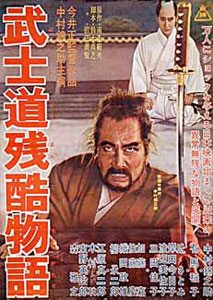Tadashi Imai's Misplaced Masterpiece:
The Ultimate in zongoku jidai-geki or Cruel Samurai Films
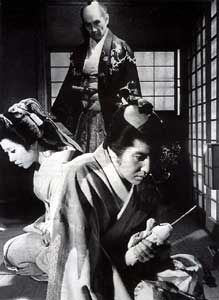 Director Tadashi Imai has a reputation among film historians in Europe as a neo-realist. He's not otherwise remembered outside of Japan, & all but unknown in the United States where his best films were distributed just about exclusively to ethnic theaters.
Director Tadashi Imai has a reputation among film historians in Europe as a neo-realist. He's not otherwise remembered outside of Japan, & all but unknown in the United States where his best films were distributed just about exclusively to ethnic theaters.
His The Rice People (Kome, 1957) portrayed farmers struggling against the greed & selfishness of the corporation they relied upon to sell their rice, with some of the farmers breaking from what they came to perceive as generations-long traditional bondage.
In his Nigorie trilogy (1954) he investigated the tribulations of women in a social system that treated them as bond servants whether as wives, servants, or prostitutes.
In Kiku & Isamu (Kiku to Isamu, 1959) he put his critical lens upon the prejudices & injustices heaped upon two Japanese boys whose fathers were black occupation soldiers, forcing audiences to assess their own deep racisms. One of his most amazing relevance-films was The River without a Bridge (Hashi no Nai Kawa, 1969) about Japan's rarely spoken of eta or outcasts.
These & other films of high merit & intelligence should've provided Imai with an international reputation, but it never happened. He is most purely "entertaining" in his samurai films, notably Revenge (Adauchi, 1965) & the subject of the present essay, Bushido: Samurai Saga (Bushido zankoku monogatari, 1963), which are no less social indictments but which permit audiences to be oblivious if they so desire. Yet even these have had only the most limited distribution outside of Japan.
Despite that during wartime he made militaristic films under threat of being sent to the front himself if he refused, he was after the war a founding member of the independent film movement, active in Communist politics, & an outspoken critic of the military.
His anti-samurai or really anti-militarist masterpiece Bushido Samurai Saga . It has occasionally been shown by the alternative titles Cruel Tales of Bushido, Cruel Stories of Samurai Ways, The Oath of Obedience, Stories of Samurai Cruelty, or simply Bushido.
It won the Berlin Film Festival's Golden Bear Award in 1962, an honor not received by a second Japanese film until Spirited Away (2001). Additionally, Kinnosuke Nakamura for his enormous display of versatility took the Blue Ribbon Award for Best Actor.
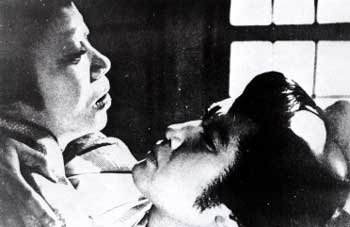 Kinnosuke Nakamura plays seven roles in consecutive generations of Iikukuras: (Jirozaemon, Sajiemon, Kyutaro, Shuzo, Shingo, Osamu, Susumu), from medieval warrior Jirozaemon to modern day salary-man Susumu. Kinnosuke Nakamura plays seven roles in consecutive generations of Iikukuras: (Jirozaemon, Sajiemon, Kyutaro, Shuzo, Shingo, Osamu, Susumu), from medieval warrior Jirozaemon to modern day salary-man Susumu.
He is essentially playing his own descendants, each generation bound by a glorious ancestor's oath of vassalage for himself & his family to a castle lord.
In our modern age when for the sake of feeling safe from terrorists American politicians are legislating away our civil rights while waging wars for oil profits, there is all too much in Bushido Samurai Saga that is as applicable to our present condition as it was to post-war Japan. Imai has in fact constructed a multi-level fable invested with an alarming degree of universality.
The cruelty of the film was part of a brief historical moment in Japanese cinema that produced another Kinnosuke jidai-geki vehicle Shark (Same, 1964) whose hero passes through a long period of apparent psychosis; Kinnosuke's brother Kazuo Nakamura in Shura (Demons, 1971) Masaki Kobayashi's gutwrenching Harakiri (Seppuku, 1964) in which Tatsuya Nakadai's character avenges the brutally horrific death of his severely maltreated son-in-law; & the same director's Samurai Rebellion (Jii-uchi: Hairyo tsuma shimatsu, 1967) in which everyone with a spark of decency is brutalized & slain by the end.
Part of the same "cruel jidai-geki" subgenre are Betrayal (Daisatsujin orochi, 1966) which portrays the one-against-all climactic battle as a horrifying catastrophe instead of an heroic event; & Kihachi Okamoto's Sword of Doom (Daibosotsu toge, 1966) which heightens the sense of evil for the antihero of the often-filmed tale of Daibosotsu Pass. These have all in common black & white "film noir" style of cinematography & a dark, grim, sorrowful attitude about medieval Japan.
There was always a streak of sadness & aesthetic cruelty in Japanese cinema & unhappy endings were vastly more common than in Hollywood films.
But the graphic brutality that arose in the 1960s was new, piloted by leftist radicals who used violence less for exploitation than to score one against romanticizing samurai & the whole caste system.
These "cruel jidai-geki" tended to linger on the horror of carnage of disembowelment with the violence disturbing rather than romantic. There's usually splendid black & white cinematography, only occasionally in full color as for Portrait of Hell (Jigokuhen, 1969) or The Retaliation of Gonza (Konu kubi ichiman-goku, 1963) due to a lingering sentiment in the industry that serious films were black & white. There was moodiness to the cinematography & invariably an intensity to the acting that made such films awesome even in their non-violent build-ups to abject violence.
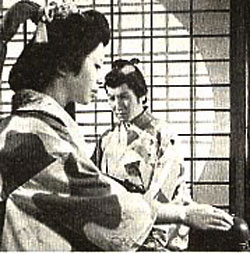 Formerly, as with the many Tange Sazen one-armed one-eyed swordsman films, even an act of betrayal with extreme physical mutilation merely resulted in a smart-mouthed superhero rather than a life irretrievably destroyed.
Formerly, as with the many Tange Sazen one-armed one-eyed swordsman films, even an act of betrayal with extreme physical mutilation merely resulted in a smart-mouthed superhero rather than a life irretrievably destroyed.
With the birth of realistic violence in the cinema, the encounter between samurai played by Mifune & Nakadai at the end of Samurai Rebellion show two characters both of whom are good people caught in webs of cultural inevitabilities that will destroy both men merely to sustain a status quo that never deserved to be sustained.
The same two actors encounter one another at the end of Sanjuro (1962), & though the hero survives, his opponent was not a villain, & his demise, accompanied with a spray of blood shooting fifteen feet out of his heart, is mindbogglingly violent tragedy rather than some sort of hip-hip-hooray for good against evil.
There were three motivating factors, sometimes overlapping for these sorts of cruel samurai tails: 1) Peasants seeking vengeance against the imbalances & oppressions of a class system, as in Onibaba (1964), Shark, & Daisuke Ito's The Retaliation of Gonza;
2) Good warriors who are driven to duel out of hubris or pride that overcomes even friendship, as in Sanjuro or Samurai Rebellion or the often-filmed encounter between Musashi & Kojiro; or,
3) The conflict of ninjo-giri meaning between duty & humanity or the outright lack of humanity when samurai turn against their own, as in Betrayal, Harakiri, or Tai Kato's Cruel Story of the Bakumatsu Period (Bakumatsu zankoku monogatari, 1964).
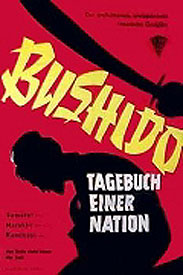 In Bushido: Samurai Saga it is the lack of humanity & overwhelming sense of duty that leads to generations of cruel events perpetrated by lords against dutiful retainers. In Bushido: Samurai Saga it is the lack of humanity & overwhelming sense of duty that leads to generations of cruel events perpetrated by lords against dutiful retainers.
Such films have all had in common a willingness to raise ethical questions. And in questioning the "romance" of feudalism, these films are actually criticisms of modern social norms that retain many feudal hold-overs. Bushido: Samurai Saga makes this most obvious by even including the closing modern episode of salariman injurious dutifulness to one's employer.
Once a certain barrier of graphic violence & depth of cruelty was shattered, it was not long before cruelty for the sake of cruelty replaced the moral, emotional, sociological, political, & spiritual contexts of that first great period of cruel tales of the samurai, & what started as beauty & horror was soon reduced to exploitation. But to this day, when a new-generation director wants to do something deadly serious with a samurai film, it is films from among those first & refined films of cruelty & sadness & injustice that are emulated.
For the bookish Japanese, there has always been a close association between popular literature & cinema. It has been suggested by Mitsuru Hashimoto in Kanpon chanbara jidaigeki koza (Tokyo: Tokuma Shoten, 1989) that the 1960s craze for cruel samurai films began with a popular collection of short stories by Norio Nanjo Zongoku monogatori (Cruel Tales, 1959), which in essence took the new-era physical & emotional cruelties of the stories by Edogawa Rampo & moved them into historical settings. Bushido, Samurai Saga was in fact based on one of his tales.
But it would be quite easy to show the origins of zongoku jidai-geki or cruel period films in many stylized tales of cruelty, revenge, & injustice in the medieval kabuki & puppet theater, with cinema's one innovation being the heightened degree of realism achievable with the camera's eye.
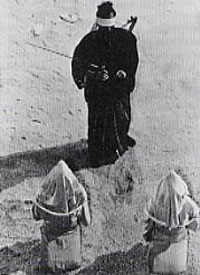 Bushido, Samurai Saga is a tremendous tour de force for Kinnosuke as actor, as well as for Imai as director. In the first generation as Jirozaemon Kinnosuke plays a well-worn warrior, grizzled & impressive, who with stunning stoicism & extreme devotion to duty ends his life through harakiri. Bushido, Samurai Saga is a tremendous tour de force for Kinnosuke as actor, as well as for Imai as director. In the first generation as Jirozaemon Kinnosuke plays a well-worn warrior, grizzled & impressive, who with stunning stoicism & extreme devotion to duty ends his life through harakiri.
All his descendants will live in vassalage to the well-served Lord Hori (Masayuki Mori playing the despot in consecutive generations). This was Jirozaemon's intentional legacy, as he believed that deeply in the feudal system.
And for that belief, a great man died for the benefit of a man void of greatness, & generations were to suffer, expected as they were, like their great ancestor Jirozaemon, to submit to any cruelty.
In one of his generations he plays a court catamite, a sweet young thing with a soar rear end, & he plays with equal conviction the archly macho older samurai Jirozaemon, & the submissive boy. That Kinnosuke can play this range is incredible.
The submissive boy falsl in love with Lady Hagi (Kyoko Kishida, that sexy-sexy Woman of the Dunes, 1964), driven together by Hori's incessant cruelty. And when he discovers their illicit affair, he outdoes himself in viciousness.
In another of the generations, Hori arranges a display of swordsmanship specifically to destroy the happiness of a loving father.
Seemingly bound to an inescapably cruel fate, director Imai ultimately shows that it is the cruel nature of obedience itself, & not fate, that has caused so much suffering through the generations, up to & including the brave young Iikura who died nobly but uselessly as a kamikaze pilot.
In the present-day generation (well, 1960s) generation, an Iikura whose wife (Yoshiko Mita) has committed suicide launched the film in a series of flashbacks as as Susumu Iikura contemplates his family's long history. When his company boss expects blind obedience from the young salaryman, Susumu moves toward free will to select a moral road rather than a road whereon duty & sacrifice outweigh human decency.
copyright © by Paghat the Ratgirl
|
